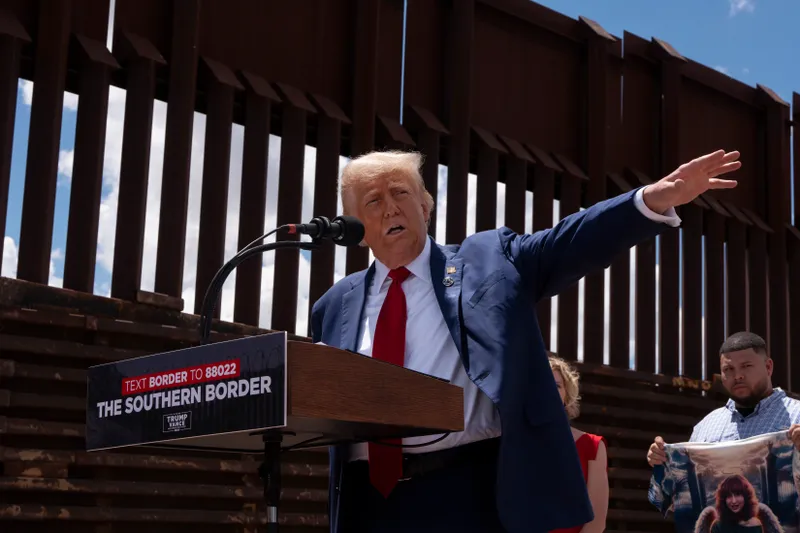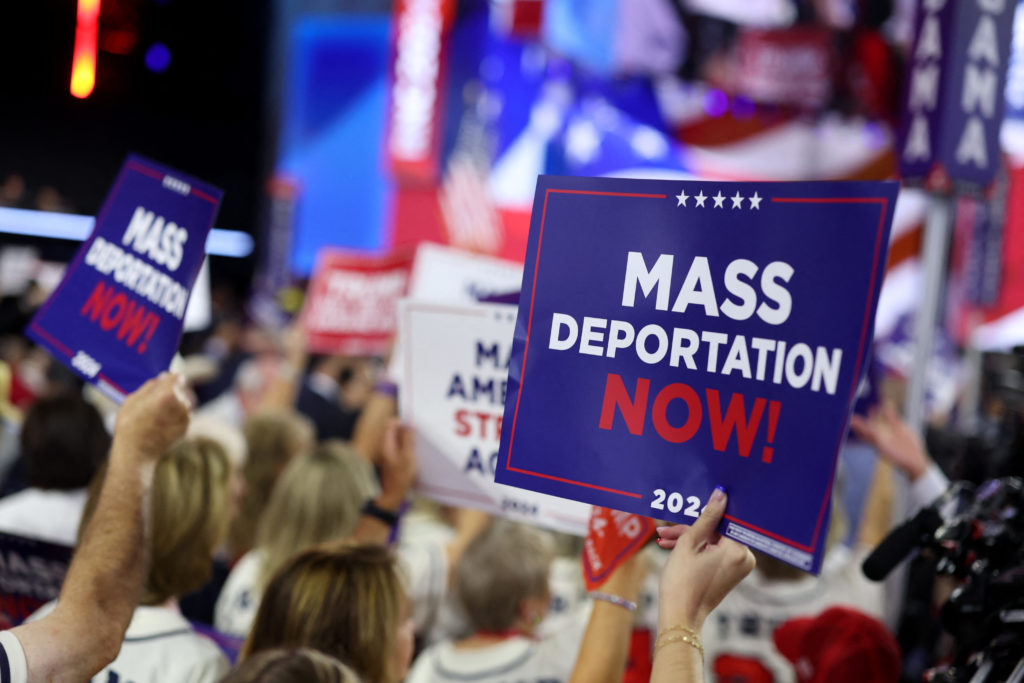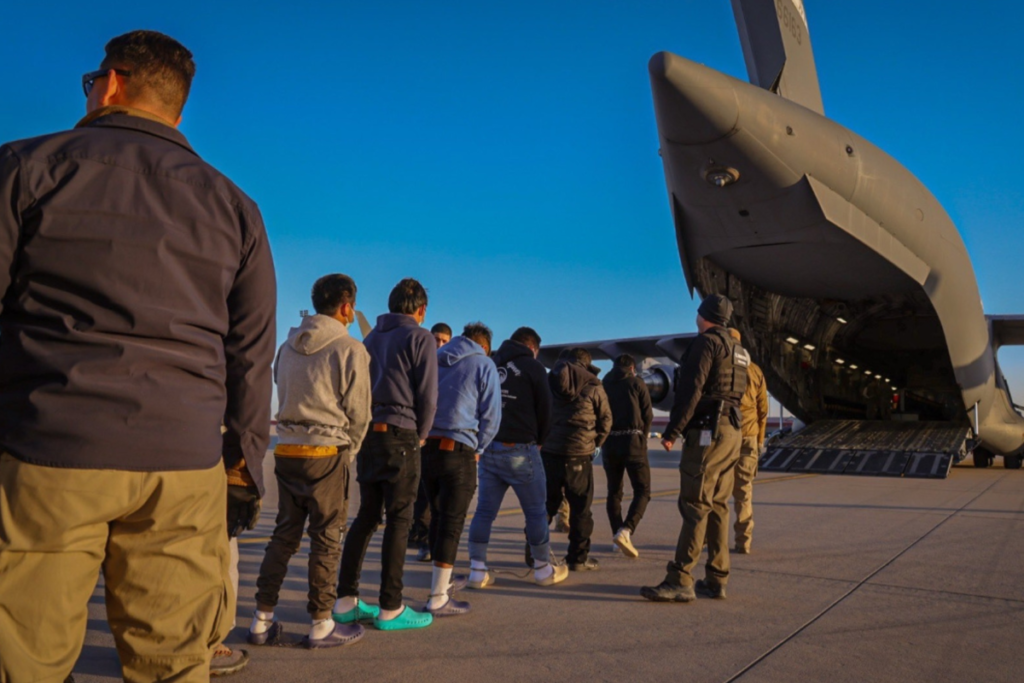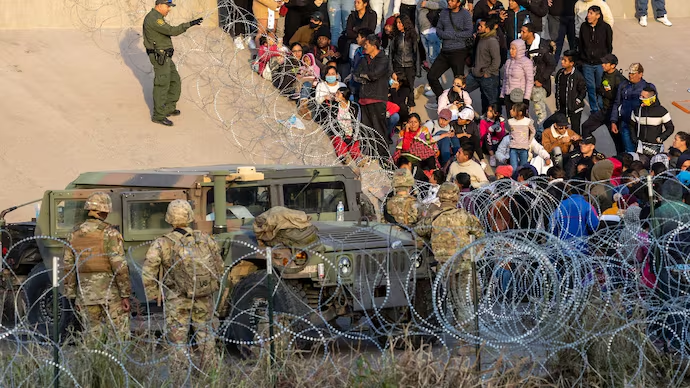
Trump Introduction and Context
The topic of Trump deporting Indian immigrants has been a significant subject of discussion, especially in 2025, as the U.S. continues its efforts to deport illegal immigrants. One major event that has garnered attention is the expected arrival of a U.S. military aircraft carrying Indian illegal immigrants. This plane is set to land in India soon, highlighting the ongoing deportation process under the Trump administration. Media coverage is anticipated once the deportees arrive, marking a significant chapter in the global discussion on immigration and deportation policies.
As the U.S. ramps up its deportation efforts, Trump’s policies continue to shape the future for Indian immigrants who have entered the country illegally. This situation represents a broader concern for many countries, including India, as they prepare to handle the return of their citizens from the U.S. This is just one example of how immigration policies and international cooperation are evolving.
| Point | Details |
|---|---|
| Immigration Debate | Trump’s policies on immigration have become a hot topic globally. |
| Media Attention | Deportations have garnered significant media coverage worldwide. |
| Deportation Policy | U.S. aims to deport 20 million illegal immigrants, including Indians. |
| Military Involvement | U.S. military aircraft are being used for deportation flights. |
| Global Impact | Countries like India are facing challenges with deportations. |
| Reactions in India | India is preparing to handle the deportees as they return. |
Flight and Deportation Process
The deportation process for Indian immigrants is currently taking place with the use of U.S. military transport planes. The flight carrying the deportees is a C-17 U.S. military transport plane, designed for long-distance journeys. The plane has already departed from the U.S. and is expected to reach India in approximately 24 hours. The process raises questions about whether India has officially agreed to accept these deportees. This question remains central to the ongoing dialogue between the two nations.
India’s role in this Trump deporting Indian immigrants 2025. is critical, as the country has to manage the return of its citizens who have entered the U.S. illegally. This situation is not unique to India, as other countries are also dealing with the deportation of their citizens. While the U.S. government covers the costs of deportation, the cooperation between the two countries is essential to ensure a smooth process.
| Point | Details |
|---|---|
| Aircraft Details | A C-17 U.S. military plane is used for deportation flights. |
| Flight Duration | The flight will take approximately 24 hours to reach India. |
| India’s Agreement | Uncertainty remains about India’s official stance on accepting deportees. |
| Deportation Process | The U.S. government covers deportation costs. |
| International Cooperation | Both the U.S. and India must collaborate for the process to be smooth. |
| Deportation Costs | U.S. government pays for the deportation flights. |

India’s Acceptance of Illegal Immigrants
India has acknowledged that there are at least 18,000 Indian illegal immigrants currently residing in the U.S. These individuals have attempted to enter the U.S. illegally, driven by the belief that life in the U.S. would offer better opportunities. Many Indian immigrants take dangerous routes, traveling through countries like Mexico or other South American nations, with the hope of reaching the U.S. border. This method of migration often involves significant risks.
The situation also highlights a broader issue regarding illegal immigration, as many countries face similar challenges with their citizens attempting to enter the U.S. illegally. While the journey is perilous, many still take the risk in the hopes of achieving the “American Dream.” India’s acknowledgment of the issue is the first step in managing the deportations and addressing the concerns raised by both the U.S. and the immigrants themselves.
| Point | Details |
|---|---|
| Indian Immigrants in the U.S. | Over 18,000 illegal Indian immigrants currently reside in the U.S. |
| Illegal Entry Methods | Many enter through Mexico or South America to reach the U.S. |
| Reasons for Migration | Immigrants are seeking better opportunities in the U.S. |
| Risks of the Journey | The journey involves significant risks, including exploitation. |
| Illegal Immigration Stats | Countries like India have significant numbers of illegal immigrants in the U.S. |
| India’s Role in Deportation | India must manage the return of its citizens under deportation policies. |
Risks and Challenges of Illegal Immigration
Trump deporting Indian immigrants 2025 Illegal immigration, especially to the U.S., presents many challenges. The journey to the U.S. is fraught with danger, and it is not only Indian immigrants who take this perilous route. Immigrants from various regions, including China, Vietnam, and South America, also attempt to enter the U.S. illegally. Many of them get caught at the U.S.-Mexico border by U.S. authorities, facing arrest and deportation.
The high risks involved in illegal immigration often involve human trafficking and exploitation, with many migrants being taken advantage of along the way. Despite the dangers, many immigrants are willing to take the risk in search of a better life, often relying on networks or smugglers to help them along the journey. These individuals are often left with few choices, driven by the need for economic opportunities and security.
| Point | Details |
|---|---|
| High-Risk Journey | The journey to the U.S. is fraught with dangers like human trafficking. |
| Other Immigrants | Immigrants from countries like China and Vietnam also attempt illegal entry. |
| Border Arrests | Many immigrants are caught at the U.S.-Mexico border. |
| Exploitation Risks | Many immigrants face exploitation from smugglers and traffickers. |
| Economic Drivers | Many immigrants are driven by the need for economic opportunities. |
| U.S. Border Patrol | U.S. authorities play a key role in preventing illegal immigration. |
Life in the U.S. as an Illegal Immigrant
Trump deporting Indian immigrants 2025 Illegal immigrants in the U.S. face a variety of challenges, even after managing to enter the country. Many find work in cities like New York, where documentation requirements may not always be strictly enforced. However, these immigrants often face low-paying jobs, limited job security, and poor working conditions. Despite these hardships, many remain determined to stay in the U.S., driven by the belief that life there offers better prospects.
The situation of these illegal immigrants raises questions about the broader issue of undocumented workers in the U.S. economy. Many contribute to the economy in essential sectors such as agriculture, construction, and service industries, despite facing exploitation and a lack of basic rights. For these immigrants, the risk of deportation is ever-present, but the desire for a better life keeps them in the country.
| Point | Details |
|---|---|
| Finding Work | Immigrants often find work in cities like New York. |
| Low Wages | Illegal immigrants tend to work in low-paying jobs. |
| Job Insecurity | They face job insecurity due to their status as undocumented workers. |
| Undocumented Workers | Many contribute to essential sectors of the U.S. economy. |
| Exploitation | Illegal immigrants often face exploitation in the workforce. |
| Deportation Risk | Despite their contributions, immigrants constantly face deportation risks. |
Scale of the Illegal Immigration Problem
The scale of illegal immigration in the U.S. is vast. It is estimated that over 750,000 Trump deporting Indian immigrants 2025 illegal Indian immigrants are currently in the U.S., with many more attempting to enter every year. Trump’s administration has set an ambitious target of deporting 20 million illegal immigrants, including a significant number of Indian nationals. India, despite its concerns, has accepted that its citizens will be returned under the current deportation policies.
This large number of illegal immigrants poses a complex challenge for both the U.S. and India. While the U.S. aims to manage its immigration policies, India is left to deal with the consequences of its citizens returning home. This complex situation is not unique to India but is being experienced by many countries worldwide.
| Point | Details |
|---|---|
| Immigrant Numbers | Over 750,000 illegal Indian immigrants are in the U.S. |
| Deportation Target | Trump’s administration aims to deport 20 million illegal immigrants. |
| India’s Role | India has accepted that its citizens will be deported. |
| Global Scope | Other countries are facing similar challenges with deportations. |
| Deportation Logistics | Coordinating large-scale deportations is a massive undertaking. |
| Public Opinion | Public opinion on deportations remains divided in both the U.S. and India. |

Flight and Deportation Process
The flight that carries the deported Indian immigrants is not only a significant event for the individuals involved but also has broader geopolitical implications. While the U.S. military’s involvement in the deportation process has been questioned, it is clear that this is a well-planned operation. As the C-17 aircraft departs the U.S., it reflects the administration’s commitment to reducing illegal immigration. This level of organization in deportation speaks to the gravity with which the U.S. is addressing immigration issues.
The return flight of deported individuals highlights the bilateral relationship between India and the U.S. India, as a recipient country, is expected to absorb its citizens back into its social and economic systems. However, it’s worth noting that there may be challenges in accommodating thousands of deported citizens, especially with the economic pressures and unemployment challenges that India is facing.
| Point | Details |
|---|---|
| Bilateral Relations | The deportation involves cooperation between the U.S. and India. |
| U.S. Military Role | The U.S. military is deeply involved in deportation logistics. |
| Flight Arrangements | The C-17 military plane is a key part of the operation. |
| Deportation Scale | The deportation is part of a larger initiative to reduce illegal immigration. |
| Indian Economic Challenges | India may face challenges accommodating large numbers of deportees. |
| Immigration Enforcement | The operation shows the U.S. administration’s commitment to enforcing immigration policies. |

The Impact on Indian Immigrants
Indian immigrants who have been deported are expected to face numerous challenges upon their return to India. Many of them have spent years or even decades in the U.S., where they have formed communities, established careers, and integrated into society. Their sudden return to India may be disorienting and challenging, as they must navigate the stark contrast between their life in the U.S. and their reintegration into India’s socio-economic landscape.
The Indian government is working to provide support to the deportees, but this process is not without its difficulties. India must address the concerns of these returning citizens, such as securing employment, housing, and medical care. Additionally, many deportees may have family members who were left behind in the U.S., making the emotional strain even more difficult to handle.
| Point | Details |
|---|---|
| Emotional Strain | Deportees may experience emotional trauma from leaving their U.S. lives behind. |
| Reintegration Challenges | Many deportees face difficulties reintegrating into Indian society. |
| Economic Hardships | Deportees may struggle to find stable jobs in India. |
| Family Separation | Deportees often face emotional distress due to separation from family members in the U.S. |
| Government Support | India is working to offer support for deportees, but resources are limited. |
| Public Perception | Indian society may view deportees in various ways, affecting their integration. |
Social Issues in the U.S.
The topic of deportation has also highlighted social issues within the U.S., especially related to how immigrants are treated upon arrival and throughout their stay in the country. Immigrants, both legal and illegal, often face discrimination, exploitation, and marginalization. While the U.S. economy heavily relies on the labor of immigrants, many still live in fear of being arrested and deported, particularly after the changes in immigration enforcement policies.
The U.S. government’s stance on deportation has led to widespread protests from immigrant rights groups, advocating for more humane treatment of undocumented immigrants. Social movements in the U.S. have called for pathways to citizenship and improved working conditions for immigrants. These movements have gained momentum in response to the increased deportation efforts under the Trump administration, with various advocacy groups and social organizations working to raise awareness and support immigrants.
| Point | Details |
|---|---|
| Immigrant Rights Movement | Groups are advocating for better treatment and rights for immigrants. |
| Discrimination and Marginalization | Immigrants, particularly illegal ones, often face discrimination. |
| Economic Dependence | The U.S. economy depends on immigrant labor, especially in agriculture and service sectors. |
| Protests and Advocacy | There has been an increase in protests against deportation policies. |
| Social Justice Movements | Social justice movements continue to push for immigrant rights and amnesty. |
| Political Influence | The issue of immigration has become a key point in U.S. politics, influencing elections. |
Policy Changes and Future of Immigration
Trump deporting Indian immigrants 2025 administration has introduced a series of policy changes to curb illegal immigration, leading to discussions about the future of immigration policy in the U.S. While deportation is one facet of the administration’s approach, there are also ongoing debates about securing the southern border and reforming legal immigration processes. The introduction of stricter immigration laws, including a reduction in work visas, has led to frustration among businesses that rely on immigrant labor.
Many of the policies enacted by the Trump deporting Indian immigrants 2025 administration, such as the construction of a border wall and increased border security measures, have been controversial. While some argue these measures are necessary to prevent illegal immigration, others view them as harmful and discriminatory. The future of U.S. immigration policy will likely depend on the political landscape and the outcome of future elections.
| Point | Details |
|---|---|
| Immigration Law Reform | Stricter immigration laws are being implemented to curb illegal immigration. |
| Border Security | The U.S. is focusing on increasing border security to prevent illegal crossings. |
| Work Visa Reduction | The reduction of work visas has affected businesses dependent on immigrant labor. |
| Political Division | Immigration policies are deeply divisive, with differing views on enforcement. |
| Legal Immigration Pathways | There is ongoing debate over creating more pathways for legal immigration. |
| Future Elections | Immigration policies will likely play a central role in future U.S. elections. |
Global Reactions to U.S. Deportation Policies
The global reaction to the U.S. deportation policies has been mixed, with some countries expressing support for the U.S.’s right to manage its immigration laws, while others have criticized the practices as inhumane. Countries like Mexico, Central American nations, and India have found themselves directly impacted by these deportations, as they must manage the return of their citizens.
International organizations, including the United Nations, have raised concerns about the human rights of deported individuals. Humanitarian organizations have warned that mass deportations can lead to social instability, as deportees struggle to reintegrate into their home countries. These concerns have sparked discussions about the broader consequences of aggressive immigration policies on a global scale.
| Point | Details |
|---|---|
| Mixed Global Reactions | Countries around the world have reacted differently to U.S. deportation policies. |
| Human Rights Concerns | The United Nations and other organizations have raised concerns about human rights. |
| Impact on Neighboring Countries | Countries like Mexico and India are directly affected by deportations. |
| Social Instability Risks | Deportations can lead to instability in the home countries of deportees. |
| Humanitarian Advocacy | Humanitarian groups continue to advocate for the protection of deportees’ rights. |
| Global Migration Crisis | The debate over deportation is part of the larger global migration crisis. |
You Might Also Like
- Will the USA Destroy Canada? The Impact of Trade War and Tariffs
- Fears of Trump: India Reduces Taxes on Harley-Davidson Bikes
- India-Russia Nuclear Energy Cooperation: Volodin’s Key Visit
The Long-Term Effects of Mass Deportations
The long-term effects of mass deportations will likely be felt in both the U.S. and the countries that receive deported individuals. In the U.S., deportations may reduce the number of illegal immigrants but could also impact industries that rely heavily on immigrant labor. As businesses adjust to a potential labor shortage, there could be economic consequences that affect both the workforce and the consumer market.
For countries like India, the sudden return of large numbers of deported citizens may put pressure on social services and employment opportunities. These deportees may require government assistance as they try to reintegrate into their home country. Moreover, the social dynamics in India could shift, with returning immigrants facing potential stigma or challenges in reintegrating with the communities they left behind.
| Point | Details |
|---|---|
| Labor Market Impact | Deportations may lead to labor shortages in certain industries. |
| Economic Consequences | Economic adjustments may be necessary in both the U.S. and India. |
| Social Reintegration | Deportees may struggle with reintegration into their home communities. |
| Stigma and Challenges | Returning immigrants could face stigma or challenges in reintegration. |
| Government Assistance | Both the U.S. and India may need to offer support to deported individuals. |
| Global Migration Trends | The deportation of millions of illegal immigrants reflects global migration trends. |



